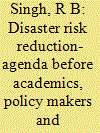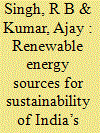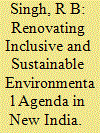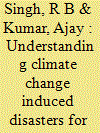|
|
|
Sort Order |
|
|
|
Items / Page
|
|
|
|
|
|
|
| Srl | Item |
| 1 |
ID:
154118


|
|
|
|
|
| Summary/Abstract |
The potential sources of clean energy carries the immense scope to meet the rising demands of energy needs, mitigating climate change impacts and ensuring sustainable development, especially while the world population has been anticipated to reach around 9 billion mark with their energy consumption of 815 Quadrillion BTU by the year 2040.
|
|
|
|
|
|
|
|
|
|
|
|
|
|
|
|
| 2 |
ID:
145375


|
|
|
|
|
| Summary/Abstract |
According to recent World Disaster Reports the percentage of occurrences of flood is highest (43 per cent) with 3062 occurrences of the total disasters during 1995-2015 followed by storms (28 per cent) with 2018 occurrences. The volcanic activities have the lowest occurrence of only 111 events (2 per cent). Others include earthquake (8 per cent), extreme temperature (6 per cent), landslide (5 per cent), drought (5 per cent) and wildfire (4 per cent). According to EM-DAT CRED the hydrological and meteorological disasters are causing loss of about USD 250 million every year.
|
|
|
|
|
|
|
|
|
|
|
|
|
|
|
|
| 3 |
ID:
102722


|
|
|
| 4 |
ID:
138381


|
|
|
|
|
| Summary/Abstract |
The domestic production of crude oil from fossil fuels remains more or less stagnant over the years and meets only one third of national requirement, while the balance is met through imports of crude petroleum products that cost huge for the country close to $90 billion in 2008-09, which have massive impact on the country’s foreign exchange reserves.
|
|
|
|
|
|
|
|
|
|
|
|
|
|
|
|
| 5 |
ID:
161233


|
|
|
|
|
| Summary/Abstract |
Indian people, academics and policy makers should utilize environment for revitalizing India taking lessons from global and national successful stories. Thinking about the future of planet and life on earth is mentioned in Rachel Carsons’s book entitled ‘Silent Spring’, published in 1962, began with a ‘fable for tomorrow’, depicting story about the use of DDT had caused damage to wildlife, birds, beet, agricultural animals, domestic pets and even human beings.
|
|
|
|
|
|
|
|
|
|
|
|
|
|
|
|
| 6 |
ID:
141237


|
|
|
|
|
| Summary/Abstract |
The global climate is changing at rates that are unprecedented in recent human history and faster than the ability of natural system to adapt. Climate change is increasingly recognized as a critical challenge to ecological health, human well-being, livelihood security and future development (Singh and Heitala, 2014), as understood by the award of the Nobel Peace Prize for 2007 to the Intergovernmental Panel on Climate Change (IPCC) (Leary et al., 2008). The risks of climate change and extreme events such as drought and flood have substantial impacts on economy and natural systems. Agriculture, livestock and water resources are among the most vulnerable systems. According to Sen Roy and Singh, 2002, changing climate elements and their extremes will significantly alter productivity in agriculture and forest ecosystem, which in turn will affect the socio-economic conditions of many societies. Climate change is expected to increase the frequency and intensity of current hazards and the probability of extreme events, and also to spur the emergence of new hazards (Nicholls and Lowe, 2006). Extreme events within the variability of the climate system are, by far, the largest cause of natural disasters worldwide each year (Kininmonth, 2004). Therefore, resilience and adaptive capacity of traditional networks and land use systems to cope with climate variability/extremes are weakening, while frequency and magnitude of climate variability and land use intensity are in rise. Thus, it is important to understand the phenomenon of climate change and associated vulnerability of different sectors, regions and people.
|
|
|
|
|
|
|
|
|
|
|
|
|
|
|
|
|
|
|
|
|